I have checked nestboxes in other areas in St. Louis in the past and based on my previous experience, I was eager to check these nestboxes because I had several questions in mind. Who would use these boxes and if there were competing bird species, which would be the dominant species? How sensitive to human disturbance would these birds be? What would happen if I opened the box and caught the adult sitting on the nest? Would that bird decide to abandon its nest? How suseptible to predation are these nestboxes and do the ventilation holes in some of the boxes make a difference in nest mortality rates?
Some these questions will not be answered immediately, but what I can tell you is that 10 out of the 12 boxes are occupied by Eurasian Tree Sparrows. As of today, the remaining 2 boxes have some nesting material at the bottom of the box but it is too soon yet to determine the species that is making the nest.
I am rather excited that the Eurasian Tree Sparrows are occupying the boxes. St. Louis is only one of a few places in the United States that supports a population of these birds. While the Eurasian Tree Sparrow is a non-native species, they do not appear to be aggressive like their cousin the House Sparrow. In fact, Eurasian Tree Sparrows will move out of areas where there are House Sparrows. House Sparrows and European Starlings vigorously compete with other birds for nesting sites and it is not uncommon for these 2 non-native species to kill native birds or boot them out of a prime nesting location. As I have stated earlier, Eurasian Tree Sparrows will simply move to another location to find good nesting spots.
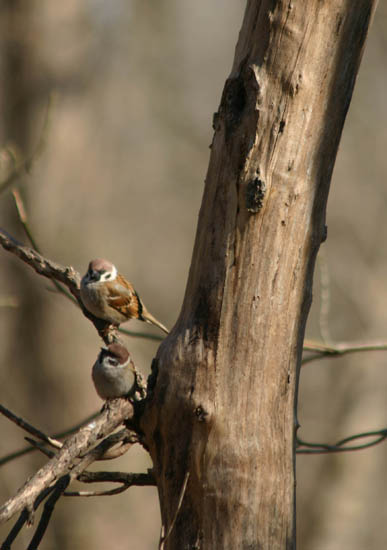
I’ve developed a process to checking the boxes. I usually check the area immediately around the nestbox. I know there’s a good chance a nestbox is occupied if I see a bird leave the box prior to my arrival or I see or hear a pair of birds fussing at me from a nearby tree.
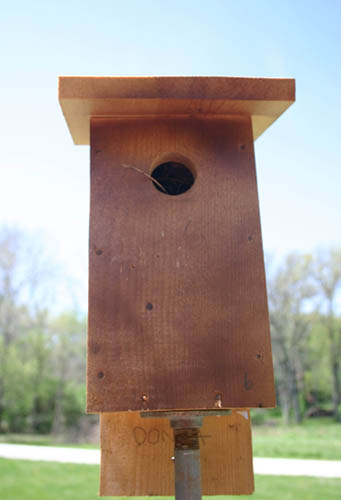
Then I open the box and peer inside. At times, opening the lid to these boxes is similiar to opening a Christmas present because you never know what you are going to get. I’ve learned the hard way to NEVER open a box and blindly stick a hand inside. The first and only time I stuck my hand into a box without looking, my hand came back covered in ants. NOT a pleasant experience. In the past I have found frogs, mice and even a snake sitting in nestboxes and have had to back off from hornet’s nests.
The next step in checking a box is determining who is occupying the box based on the nest that is inside. Most of the time the bird will be long gone by the time I arrive but identifying the nest is relatively simple process. Bluebirds have tidy nests composed of twigs, plant stems and some feather down. Chickadees also create a nice neat nest, but theirs is composed mostly of moss. Eurasian Tree Sparrows however, create an orb-shaped nest and cram the box full of dry grass, sticks and feathers with the inner portion lined with down. As you can see here, it can be difficult to stick a hand inside.
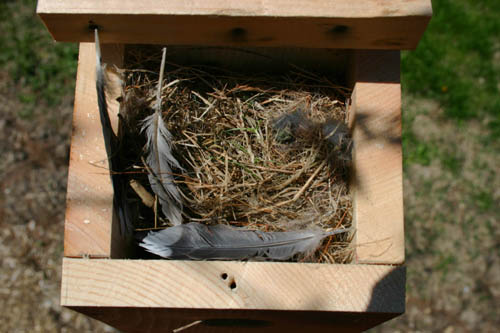
This is the point where I will blindly feel around for eggs or birds. (It is usually safe at this point to poke around blindly, since I have determined there will be no unpleasant surprises) The birds create a narrow tunnel from the entrance of the box down to their eggs while the remainder of the box is filled to the gills with plant stems and such. It is amazing how crammed full these boxes can get.
Eurasian Tree Sparrows have oval, creme-colored eggs that have varying degrees of brown spots and speckles.
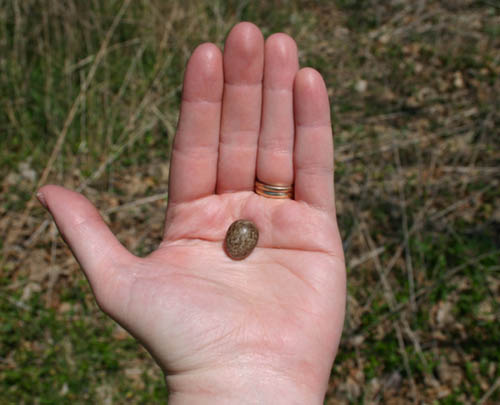
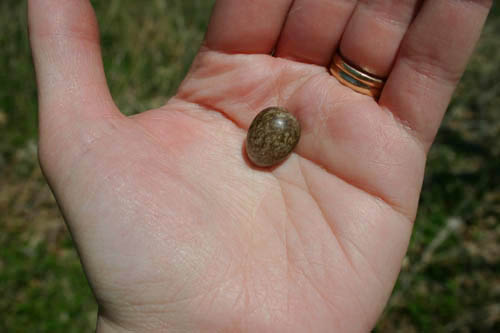
Eurasian Tree Sparrows will usually begin nesting in April and can have up to 3 clutches of eggs during the breeding season, which lasts into August. These birds will lay 4-6 eggs that will hatch after 11-14 days of incubation. The young birds will leave the nest 12-14 days later.
After a month of checking the boxes, I have come up with more questions. Why are the Eastern Bluebirds not using the nestboxes? Both the Bluebirds and Tree Sparrows begin nesting around the same time. Are the Eurasian Tree Sparrows reaching the boxes first, before the Bluebirds? Or are there enough natural cavities for the Eastern Bluebirds to use for nesting sites so they are simply not interested in the boxes? Have the Bluebirds used the boxes in the past, or has it always been the Eurasian Tree Sparrows? Or, is it possible that the LREC property just isn’t quite a prime location for Bluebirds to raise young? These questions will require a few years of nestbox observation and birdwatching before they can be answered.
In the meantime, keep your eyes peeled for young Eurasian Tree Sparrows. They will be coming!
RESOURCES
Baicich, Paul J, 1997, A Guide to the Nests, Eggs and Nestlings of North American Birds. San Diego: Natural World Academic Press.
Sibley, David Allen, 2001, The Sibley Guide to Bird Life and Behavior. New York: Alfred A. Knopf Publishing.